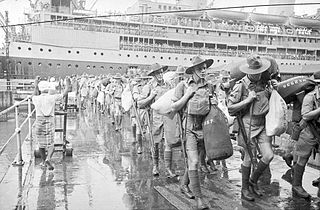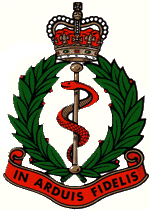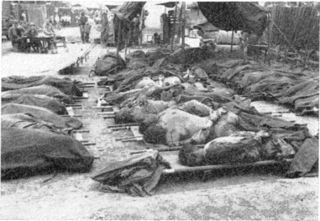
Tomoyuki Yamashita was a Japanese convicted war criminal and general in the Imperial Japanese Army during World War II. Yamashita led Japanese forces during the invasion of Malaya and Battle of Singapore, with his accomplishment of conquering Malaya and Singapore in 70 days earning him the sobriquet "The Tiger of Malaya" and led to the British Prime Minister Winston Churchill calling the ignominious fall of Singapore to Japan the "worst disaster" and "largest capitulation" in British military history. Yamashita was assigned to defend the Philippines from the advancing Allied forces later in the war, and while unable to prevent the Allied advance, he was able to hold on to part of Luzon until after the formal Surrender of Japan in August 1945.

The 17th (Northern) Division was an infantry division of the British Army, a Kitchener's Army formation raised during the Great War.

The 8th Division was an infantry division of the Australian Army, formed during World War II as part of the all-volunteer Second Australian Imperial Force. The 8th Division was raised from volunteers for overseas service from July 1940 onwards. Consisting of three infantry brigades, the intention had been to deploy the division to the Middle East to join the other Australian divisions, but as war with Japan loomed in 1941, the division was divided into four separate forces, which were deployed in different parts of the Asia-Pacific region. All of these formations were destroyed as fighting forces by the end of February 1942 during the fighting for Singapore, and in Rabaul, Ambon, and Timor. Most members of the division became prisoners of war, waiting until the war ended in late 1945 to be liberated. One in three died in captivity.

The fall of Singapore, also known as the Battle of Singapore, took place in the South–East Asian theatre of the Pacific War. The Japanese Empire captured the British stronghold of Singapore, with fighting lasting from 8 to 15 February 1942. Singapore was the foremost British military base and economic port in South–East Asia and had been of great importance to British interwar defence strategy. The capture of Singapore resulted in the largest British surrender in its history.

The Battle of Hong Kong, also known as the Defence of Hong Kong and the Fall of Hong Kong, was one of the first battles of the Pacific War in World War II. On the same morning as the attack on Pearl Harbor, forces of the Empire of Japan attacked the British Crown colony of Hong Kong around the same time that Japan declared war on Great Britain. The Hong Kong garrison consisted of British, Indian and Canadian units, also the Auxiliary Defence Units and Hong Kong Volunteer Defence Corps (HKVDC).

The Royal Army Medical Corps (RAMC) is a specialist corps in the British Army which provides medical services to all Army personnel and their families, in war and in peace. The RAMC, the Royal Army Veterinary Corps, the Royal Army Dental Corps and Queen Alexandra's Royal Army Nursing Corps form the Army Medical Services.

The Royal Malay Regiment is the premier unit of the Malaysian Army's two infantry regiments. At its largest, the Malay Regiment comprised 27 battalions. At present, three battalions are parachute trained and form part of the Malaysian Army Rapid Deployment Force. Another battalion has been converted into a mechanised infantry battalion while the remaining battalions are standard light infantry. The 1st Battalion Royal Malay Regiment acts as the ceremonial foot guards battalion for the Yang di-Pertuan Agong, and is usually accompanied by the Central Band of the Royal Malay Regiment. As its name suggests, the regiment only recruits ethnic Malays.

The Battle of Pasir Panjang, which took place between 13 and 15 February 1942, was part of the final stage of the Empire of Japan's invasion of Singapore during World War II. The battle was initiated upon the advancement of elite Imperial Japanese Army forces towards Pasir Panjang Ridge on 13 February.

Syonan, officially Syonan Island, was the name for Singapore when it was occupied and ruled by the Empire of Japan, following the fall and surrender of British military forces on 15 February 1942 during World War II.

Gun Club Hill Barracks are barracks in King's Park, or in Jordan, Hong Kong formerly used by British Army garrisons during British colonial rule. The military began using the area shortly after 1860 when the British acquired Kowloon. The barracks are bounded by Austin Road, Jordan Path, Gascoigne Road and Chatham Road South.
Alexandra Hospital (AH) is a hospital located in Queenstown, Singapore that provides acute and community care under the National University Health System.

The Wormhoudt massacre was the mass murder of 81 British and French POWs by Waffen-SS soldiers from the 1st SS Division Leibstandarte SS Adolf Hitler during the Battle of France in May 1940.

British Military Hospitals were established and operated by the British Army, both at home and overseas during the 19th and 20th centuries, to treat service personnel. They varied in size, purpose and permanence.

Fort Pasir Panjang or Labrador Battery is located within Labrador Park at the southern tip of Singapore island. It was one of the 11 coastal artillery forts built by the British in the 19th century to defend the western passageway into Keppel Harbour against piracy and foreign naval powers. During the 1942 Battle of Pasir Panjang, the fort played a supporting role but a limited one in defending the Malay Regiments against the Japanese invasion at Bukit Chandu. In 1995, the site was gazetted by the National Heritage Board as one of the 11 World War II sites in Singapore.

The Changi Air Base is an airfield military airbase of the Republic of Singapore Air Force (RSAF) and United States Air Force (USAF) located at Changi, in the eastern tip of Singapore. Sited at two locations to the east and west of Singapore Changi Airport, it co-shares runway facilities with the civilian airport and currently occupies a third runway slated for future expansion for civilian use by Singapore Changi Airport. Together, the two airfields house 121 Squadron, 112 Squadron, 145 Squadron, the Field Defence Squadron, the Air Logistics Squadron and the Airfield Maintenance Squadron. The air base badge carries the motto Together in Excellence.
The St. Stephen's College massacre involved a series of war crimes committed by the Imperial Japanese Army on 25 December 1941 during the Japanese occupation of Hong Kong at St Stephen's College.
The 27th Brigade was a brigade-sized infantry unit of the Australian Army. The brigade was the last Second Australian Imperial Force infantry brigade raised for service during World War II. Initially assigned to the 9th Division, the brigade was transferred to the 8th Division shortly after it was raised. Training was undertaken around Bathurst, New South Wales throughout early 1941, before the brigade was sent to British Malaya in August 1941 to reinforce the 22nd Brigade, which had been dispatched earlier in the year. Following the Japanese invasion of Malaya, the brigade went into action in January 1942, taking part in the fighting along the western side of the Malay Peninsula. Its main action during this period came around Muar before the withdrawal to Singapore. In February, the brigade took part in the short lived Battle of Singapore. When the garrison surrendered on 15 February, the majority of the brigade's personnel were taken prisoner. They subsequently spent the remainder of the war in captivity before being released in August 1945.

The Hill 303 massacre was a war crime that took place during the opening days of the Korean War on August 17, 1950, on a hill above Waegwan, Republic of Korea. Forty-one United States Army (US) prisoners of war were murdered by troops of the North Korean People's Army (KPA) during one of the engagements of the Battle of Pusan Perimeter.

2nd Medical Brigade is a formation of the British Army formed under 1st UK Division. It predominantly provides deployed hospital care via 13 Field Hospitals. It also provides specialist medical capabilities via three Nationally Recruited Units; 306 Hospital Support Regiment, 335 Medical Evacuation Regiment and Medical Operational Support Group.


















